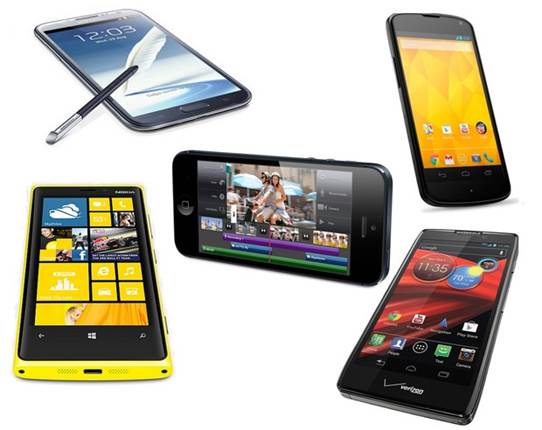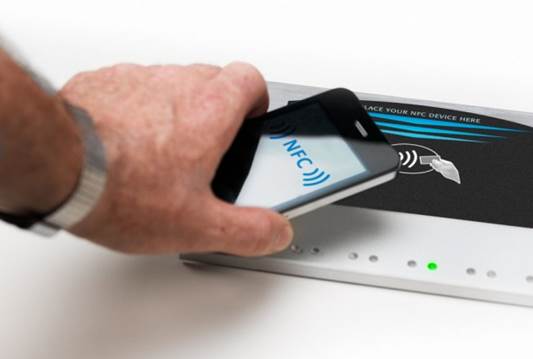Near field communication approaches
mainstream
A billboard advertisement for a luxury
sports car you were dreaming about catches your eye as you wait in line for a
taxi. The ad displays a website URL for information about a test drive, which
you copy onto your smartphone by physically pressing it against the display.
After getting in a cab to go to a trade show, you access the Web address on
your smartphone to schedule an appointment at your local car dealership the
next day. You then pay the fare and tip by once again holding the phone against
an electronic tag that is inside the cab as the driver lets you off in front of
the convention center.

You
use your smartphone to buy a sandwich for lunch and, at the end of the workday,
check into your hotel and, later on, pass through the ticket gate at an NBA
basketball game
You exchange contact and other information
throughout the day by touching your phone against name tags and booth kiosks.
You use your smartphone to buy a sandwich for lunch and, at the end of the
workday, check into your hotel and, later on, pass through the ticket gate at
an NBA basketball game. You do all this without ever having to pay with cash,
use a credit card, or even reach for your wallet.
The scenario illustrates what analysts say
will become an increasingly common way for consumers to pay for things and
access information: by adopting NFC (near field communication) technology. When
and if NFC becomes as ubiquitous as Bluetooth and other wireless technologies
are, enterprises could reap great rewards by using the technology for marketing,
identification, and retail applications.
The technology primer
NFC technology uses a chip design and
wireless standard that proponents say offer advantages that are lacking in
competing wireless technologies, such as Bluetooth, SMS, RFID, or SMS connections.
NFC’s main feature is its relative rapidity and ease of use. By removing the
need to wait for a handshake with another device or requiring additional user
input, NFC’s data transfer is almost immediate; the user only has to place the
NFC chip against an NFC reader (or within a 20cm distance) to initiate an
almost-immediate data transfer.

NFC
technology uses a chip design and wireless standard
While the technology has existed for a
number of years, its more rapid adoption recently is attributed to the use of a
single NFC standard. Many enterprises initially balked at the risk of using a
technology based on different and often proprietary flavors of NFC that were
often incompatible.
But now that the standards issue is
resolved, NFC’s low price makes it especially enticing. OEMs are also
increasingly equipping smartphones with NFC devices, a measure that is also
stoking growth. According to Forrester Research (www.forrester.com), the final total for
worldwide NFC-equipped handset shipments in 2012 is expected to more than
double to 80 million units compared to 35 million units shipped in 2011.
Consumers are thus increasingly able to use NFC-enabled smartphones to connect
to NFC readers that are attached to clothing, fast-food restaurant counters,
ticket gates, billboard advertisements, and other objects.
“It now looks increasingly likely that
adoption will accelerate in the one important segment of the market, which is
the mobile phone,” says Mark Hung, a research director with Gartner Research (www.gartner.com). “All major smartphone
vendors, with the notable exception of Apple, have shipped NFC handsets.” Manufacturers
will also increasingly embed laptops, tablets, and other devices with NFC
chips.
Beyond payment
NFC’s wide-scale adoption does not
completely hinge on its success as a means of payment, despite the hype.
Merchants’ and advertisers’ use of the technology to engage and share
information with customers is another example of an application that should
eventually see large-scale adoption. At kiosks or billboard displays, consumers
will be prompted to use their NFC-enabled devices to upload content such as
coupons or product information.

Your
phone becomes your ticket
Ticket entry is another promising
application for NFC, says Clive Long bottom, analyst and founder of Quocirca (www.quocirca.com). “Your phone becomes your
ticket, and by bumping it to a device or passing close enough for the device to
be read, you are green-lighted for entry,” Long bottom says. “This then passes
on to a more advanced form of entry, such as security at airlines gates. Your
phone becomes your boarding card, which gets you through . . . initial entry,
check-in, and baggage security, and onto the plane itself.”
Enterprise internal
Enterprises can also potentially benefit
from the use of NFC beyond sales and marketing applications. As an internal
security-check technology, for example, card-based NFC devices can be used to
log the movement of employees, contractors, and visitors at an organization’s
facility.

A
card-based NFC system could work well when combined with the actual physical
use of the cards for swiping at defined points
“A card-based NFC system could work well
when combined with the actual physical use of the cards for swiping at defined
points, such as where the user needs to be prompted when entering a specific
type of secured area,” Long bottom says.
Eventually, enterprises could save money by
relying on employees’ devices as part of a BYOD (bring your own device) policy
if and when NFC-enabled smart phones become the norm. “The biggest thing you
need to outfit employees with is the phones themselves [for enterprise use],”
says Jeffrey Hammond, a vice president and principal analyst for Forrester.
“However,” Hammond adds, “while a majority
of companies are shifting over to BYOD mobile strategies, I expect to see
employers wait for NFC to saturate the consumer market first.”